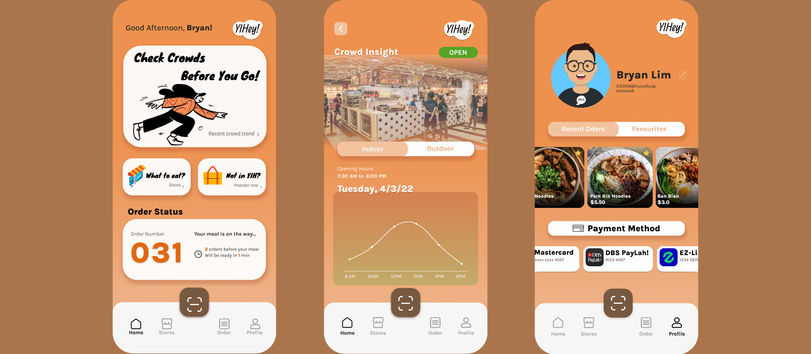
UI/UX Design
These are some of my UI/UX projects during my time in NUS.
For UI, I used various software such as Figma, Adobe Illustrator and Photoshop for prototyping app flow and graphical assets. I also utilise coding in JavaScript, Microbit as well as Arduino.
For UX, These design solutions were derived from interviews, persona creations, observations, role playing and user testing.
YIHey!
This project focuses on human centered design and how we might improve an eatery in NUS based on its current state.
As a group of 5, we did extensive research and observation of the YIH eatery in NUS. We interviewed users of the eatery and created personas to guide our design direction. Upon pinpointing two major design opportunities, we created...
TRAYbles, a support grid to enable trays to become tables. This facilitates diners in using trays to contain their food spillage as well as to return their used trays. This solution aims at expediting cleaners' jobs as well as having a higher table turnover rate for dining customers.
We also created a self ordering and pick up system, YIHey! within the NUS uNivUS app to facilitate takeaway diners in ordering and receiving their food as fast as possible to avoid congestion around the narrow spaces around the stalls.

KIVE
This is a project in collaboration with Keppel land to design the future of work.
As a group of 3, we did extensive primary and secondary research of working adults and their work conditions in Singapore. Based on the group of office workers we interviewed, the largest problem faced at work was having a toxic work environment. We decided that for our project, the future of work would be to ensure that every office environment is well equipped and educated to provide a supportive and pleasant working experience for its employees.
We designed a campaign project that will help improve work culture for office workers. Through many prototypes, mock ups, iterations as well as role playing sessions to facilitate user testing, we were able to craft...
KIVE, a Kindness Hive. KIVE is a web extension that uses a data informed approach to support an 8 week long campaign to identify users' preferred form of kindness to enable a smooth habitual formation of giving and receiving kindness at work.

NavNUS
This project focuses on redesigning a feature in an app based on user feedback. I chose to work with the NUS uNivUS app and interviewed a group of users on their experience with the map feature. Many found difficulties in using its map function.
I then made a concept prototype improving the ease of usage of the map on Figma. The map incorporates helpful detailed wayfinding instruction and information such as elevation and roadblocks. It also provides a snapshot of the location landmark. Furthermore, students are able to cross check the timetable of their classrooms to ensure that their class will be held there. Lastly, a timer was added to further help users plan their travel journey and reach their locations on time.

WASD Glove
This project required us to code and create a snake game using Arduino, using a controller of a unique concept.
I am a PC gamer who uses the WASD keys on my keyboard for every game. So I decided to create a gaming glove which mimics the pressing of WASD keys on a keyboard.
Each finger has a conductive strip of aluminum assigned to the specific "W/A/S" keys, mimicking the placement of users' hands on the keyboard. The "D" key is on the middle section of the middle finger. To trigger a specific key, users will touch their key assigned fingers to their thumbs, where the aluminum strip is assigned to the ground signal.. .

TENG-Pong
This project required us to code and create a fun exercising experience using a triboelectric nanogenerator.
The triboelectric effect is the transfer of mechanical energy into electrical energy typically through friction and electronegativity. In our case, when a silicone ball rolls past the aluminum foil, we are able to measure the fast and sporadic movements of the ping pong ball passing through the conductive checkpoints and then use the data input as a point scoring system for our game. With TENG-pong, players can compete through a visual display of strength speed and strategy whilst creating an exciting subconscious means of exercising your upper body at the same time.




























